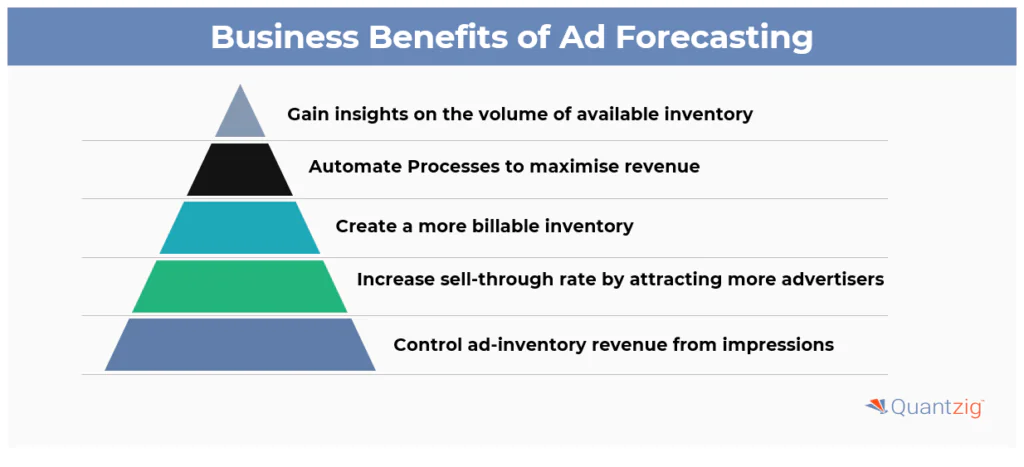Table of Contents
- What is Inventory Forecasting?
- Why is Inventory Forecasting Crucial?
- Benefits of Inventory Forecasting
- How Inventory Forecasting Works
- Best Practices for Inventory Forecasting
- Role of ERP in Inventory Forecasting
- Understanding Customers’ Demands
- Ad Inventory Forecasting: Business Advantage of Forecasting
- Why Choose Quantzig’s Ad Inventory Optimization Solutions
Inventory forecasting is a crucial tool for publishers and advertisers to predict the availability and demand of ad slots or impressions in the future. It helps optimize ad strategies, allocate resources more effectively, and ensure optimal delivery and revenue. Here are the key points:
Table of Contents
What is Inventory Forecasting?
Inventory forecasting involves predicting the availability and demand of ad slots or impressions in the future, typically over a specified period. This capability helps publishers, buyers, and ad networks optimize their ad strategies and allocate resources more effectively.
Why is Inventory Forecasting Crucial?
Inventory forecasting is crucial for several reasons:
- Optimized Inventory: It ensures that the right amount of inventory is available to meet customer demands, avoiding overstock and stockouts.
- Improved Customer Service: Accurate inventory forecasts enable businesses to meet customer demands promptly, reducing backorders and enhancing overall customer satisfaction.
- Cost Reduction: By avoiding overstock situations and minimizing holding costs, inventory forecasting contributes to cost reduction, optimizing financial resources, and improving overall profitability.
- Enhanced Supply Chain Efficiency: Inventory forecasting facilitates better coordination across the supply chain, enabling smoother production planning, reduced lead times, and improved overall efficiency in the procurement and distribution processes.
- Reduced Cost: Inventory forecasting helps reduce costs by avoiding overstock situations and minimizing holding costs.
Book a demo to experience the meaningful insights we derive from data through our ai analytics tools and platform capabilities. Schedule a demo today!
Request a free demoBenefits of Inventory Forecasting
The benefits of inventory forecasting include:
- Optimized Stock Levels: Inventory forecasting helps maintain optimal stock levels by accurately predicting Inventory and Warehousing Management demand, preventing excess inventory costs or stockouts, and ensuring efficient use of warehouse space.
- Improved Customer Service: Accurate inventory forecasts enable businesses to meet customer demands promptly, reducing backorders and enhancing overall customer satisfaction.
- Cost Reduction: By avoiding overstock situations and minimizing holding costs, inventory forecasting contributes to cost reduction, optimizing financial resources, and improving overall profitability.
- Enhanced Supply Chain Efficiency: Inventory forecasting facilitates better coordination across the supply chain, enabling smoother production planning, reduced lead times, and improved overall efficiency in the procurement and distribution processes.
- Reduced Cost: Inventory forecasting helps reduce costs by avoiding overstock situations and minimizing holding costs.
How Inventory Forecasting Works

Inventory forecasting uses upcoming events, trends, and past data to estimate the level of inventory needed for the future. It involves analyzing historical sales data and identifying patterns and trends to adapt to changing market conditions and meet customer demands.
Best Practices for Inventory Forecasting
AI-driven Media Ad Inventory Forecasting enhances Media Advertisement Inventory Management by providing accurate Inventory Forecasting and Demand Planning for advertisers. Utilizing real-time data insights, it adapts to market fluctuations, optimizing pricing strategies and discount strategies. This approach ensures ad campaigns are effectively targeted to the right audiences, improving campaign success and maximizing inventory utilization. Some best practices for inventory forecasting include:
- Gathering Data: Collect data from your sales history, ensuring it is accurate and comprehensive.
- Using an Inventory Management Program: Utilize an inventory management program that uses documental data from the sales history.
- Identifying Trends: Prioritize comprehensive trend identification and analysis to improve the accuracy of inventory forecasting.
- Real-time Data Insights: Use real-time data insights and automation to increase accuracy through the different ad ops stages.
- Data-Backed Decisions: Make data-backed decisions based on historical advertiser trends to create product bundles and achieve better returns on underperforming inventory.
Role of ERP in Inventory Forecasting
Enterprise Resource Planning (ERP) software plays a significant role in inventory forecasting. It centralizes data from every department and promotes smooth data flow to accelerate operations across production, accounting, inventory, warehouse, supply chain, finance, and other departments. Modern ERP systems allow managers real-time access to critical business data and provide integrated inventory forecasting tools for enhanced business performance.

Furthermore, media inventory forecasting helps companies manage their relationships with advertisers and clients. By providing actionable insights into future ad availability, companies can negotiate and secure ad placements in advance, ensuring that their clients’ campaigns are executed smoothly and efficiently. In this supercompetitive landscape, where consumer touchpoints are multiplying, this tool becomes even more critical. It allows ad companies to stay ahead of the competition by identifying emerging trends, understanding consumer behavior across different channels, and adapting their advertising strategies accordingly.
Experience the advantages firsthand by testing a customized complimentary pilot designed to address your specific requirements. Pilot studies are non-committal in nature.
Request a free pilotUnderstanding customers’ demands:
Understanding audience behavior is crucial for effective ad delivery. By analyzing historical data and trends, companies can anticipate user behavior changes and adjust inventory accordingly for their return on investment. Multiple data sources, like traffic analytics and ad server reports, provide a comprehensive view for informed decisions.
Industry benchmarks help identify improvement areas, while sensitivity analysis ensures robust forecasting models. Effective communication between sales teams and data analysts is essential; sales teams offer market insights, while analysts gather data from various platforms.
Efficient data processing is necessary for managing large volumes, but companies must be aware of data quality limitations, as inaccurate or incomplete data can affect forecast accuracy.
Ad Inventory Forecasting: Business Advantage of Forecasting
AI-driven Media Ad Inventory Forecasting revolutionizes Media Advertisement Inventory Management by offering precise Inventory Forecasting and Demand Planning. It helps advertisers optimize pricing strategies and discount strategies, leveraging real-time data insights to adapt to market fluctuations. This ensures ad campaigns reach the right audiences, enhancing campaign success and maximizing profitability.
- A reduction in the number of penalties for under-delivered campaigns will, in turn, increase retention rates.
- The ability to sell more ads will improve the sell-through rate helping advertising companies to attract more advertisers.
- Identifying and selling inventory to the most valuable clients can help drive revenue.
- Determining the future situations, conditions, and events that may take place. It strategically thinks about the unpredictable future and what is going to happen in the future. Thus, it helps an organization to think thoroughly and wisely about its future.
- Involving a proper analysis of the requirements, needs, and preferences of targeted customers. It allows the business to find and search for what a customer’s demand is and how to meet it. Thus, it enables a business to provide better customer satisfaction as compared to their competitors.
Why Choose Quantzig’s Ad Inventory Optimization Solutions?
The huge volumes of data available for ad campaign planning and targeting make traditional forecasting methods obsolete. Ad companies that rely on spreadsheets and traditional tools are no longer able to produce reliable forecasts that they can act on. However, it’s crucial to note that when more data is being generated, the more inaccurate these approaches can become, and this is only aggravated by the increased use of third-party data targeting and frequency capping solutions.
Quantzig’s advanced ad inventory forecasting and optimization solutions can help companies analyze ad consumption patterns, device preferences, and market trends to identify the optimal slots and prices for ad spaces. Leveraging our solutions can help managers tackle the biggest challenge- improving profits while ensuring better returns on the advertising investments made by the clients.
Our media inventory forecasting solutions also empower ad companies to:
Get started with your complimentary trial today and delve into our platform without any obligations. Explore our wide range of customized, consumption driven analytical solutions services built across the analytical maturity levels.
Start your free pilot



